|
Cortinarius acutus (Pers.:Fr.) Fr.
|
New classification: Basidiomycota/Agaricomycotina/Agaricomycetes/Agaricomycetidae/Agaricales/Cortinariaceae
Former classification: Basidiomycota/Homobasidiomycetes/Agaricomycetideae/Cortinariales/Cortinariaceae/Cortinarieae
[sub-genus:Telamonia]
synonyms: Telamonia acutus, Telamonia acuta, Cortinarius detonsus ss.MoŽn-loc.
(unconfirmed synonyms: Hydrocybe acuta, Hydrocybe acutus)
edibility : inedible
|
|
|
The cap is pale ochre yellow to pale beige, sharply campanulate, with a central umbo; its margin is striate.
The cap surface is smooth, not viscid nor sticky.
The stem is honey coloured, with a ring zone.
The flesh is pallid, darker towards stem base, unchanging; its taste is mild; the odour is faint;
its texture is fibrous.
The gills are ochre yellow to rusty red, adnate to emarginate, crowded .
The spore print is rusty brown. This species is mycorrhizal.
It grows on the ground, in damp places, with conifers.
The fruiting period takes place from July to November.
| Dimensions: | width of cap approximately 2 cm (between 1 and 3 cm) |
| | height of stem approximately 5 cm (between 4 and 6 cm) |
| | thickness of stem (at largest section) approximately 1.5 mm (between 1 and 2 mm) |
Chemical tests : none.
Distinctive features : very sharp umbonate umbo, pixie bonnet shaped, with a striate margin; faint odour of iodine; smaller gills welded to main gills; in damp places
Cortinarius acutus is quite rare and localised in the forest of Rambouillet, and is frequent, more generally speaking
.
|  | | Above : distribution map of Cortinarius acutus in the forest of Rambouillet |
|
page updated on 14/01/18
